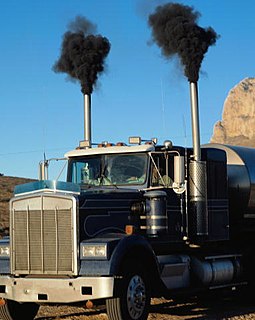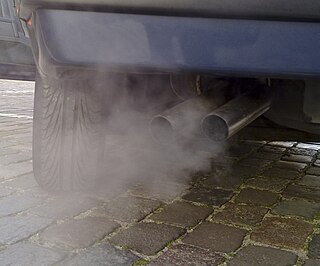
A pollutant is a substance or energy introduced into the environment that has undesired effects, or adversely affects the usefulness of a resource. A pollutant may cause long- or short-term damage by changing the growth rate of plant or animal species, or by interfering with human amenities, comfort, health, or property values. Some pollutants are biodegradable and therefore will not persist in the environment in the long term. However, the degradation products of some pollutants are themselves polluting such as the products DDE and DDD produced from the degradation of DDT.

Exhaust gas or flue gas is emitted as a result of the combustion of fuels such as natural gas, gasoline (petrol), diesel fuel, fuel oil, biodiesel blends, or coal. According to the type of engine, it is discharged into the atmosphere through an exhaust pipe, flue gas stack, or propelling nozzle. It often disperses downwind in a pattern called an exhaust plume.
Volatile organic compound (VOC) are organic chemicals that have a high vapour pressure at room temperature. High vapor pressure correlates with a low boiling point, which relates to the number of the sample's molecules in the surrounding air, a trait known as volatility.
The National Emissions Standards Act, officially known as the Motor Vehicle Air Pollution Control Act, is a 1965 amendment to the U.S. Clean Air Act of 1963. The amendment set the first federal vehicle emissions standards, beginning with the 1968 models. These standards were reductions from the 1963 emissions: 72% reduction for hydrocarbons, 56% reduction for carbon monoxide, and 100% reduction for crankcase hydrocarbons. The impact the regulatory standards will have on air quality in the future, as well as the potential characteristics of the vehicle fleet can be analyzed with the use of roadway air dispersion models.
The National Emission Standards for Hazardous Air Pollutants, also using the acronym NESHAP, are emission standards set by the United States Environmental Protection Agency—EPA. The standards are for air pollutants not covered by National Ambient Air Quality Standards—NAAQS, that may cause an increase in fatalities or in serious, irreversible, or incapacitating illness.
A State Implementation Plan (SIP) is a United States state plan for complying with the federal Clean Air Act, administered by the Environmental Protection Agency (EPA). The SIP, developed by a state agency and approved by EPA, consists of narrative, rules, technical documentation, and agreements that an individual state will use to control and clean up polluted areas.
New Source Performance Standards (NSPS) are pollution control standards issued by the United States Environmental Protection Agency (EPA). The term is used in the Clean Air Act Extension of 1970 (CAA) to refer to air pollution emission standards, and in the Clean Water Act (CWA) referring to standards for water pollution discharges of industrial wastewater to surface waters.

Atmospheric dispersion modeling is the mathematical simulation of how air pollutants disperse in the ambient atmosphere. It is performed with computer programs that include algorithms to solve the mathematical equations that govern the pollutant dispersion. The dispersion models are used to estimate the downwind ambient concentration of air pollutants or toxins emitted from sources such as industrial plants, vehicular traffic or accidental chemical releases. They can also be used to predict future concentrations under specific scenarios. Therefore, they are the dominant type of model used in air quality policy making. They are most useful for pollutants that are dispersed over large distances and that may react in the atmosphere. For pollutants that have a very high spatio-temporal variability and for epidemiological studies statistical land-use regression models are also used.

The AP 42 Compilation of Air Pollutant Emission Factors is a compilation of the US Environmental Protection Agency (EPA)'s emission factor information on air pollution, first published in 1968. As of 2018, the last edition is the 5th from 2010.

Roadway air dispersion modeling is the study of air pollutant transport from a roadway or other linear emitter. Computer models are required to conduct this analysis, because of the complex variables involved, including vehicle emissions, vehicle speed, meteorology, and terrain geometry. Line source dispersion has been studied since at least the 1960s, when the regulatory framework in the United States began requiring quantitative analysis of the air pollution consequences of major roadway and airport projects. By the early 1970s this subset of atmospheric dispersion models were being applied to real world cases of highway planning, even including some controversial court cases.

The AERMOD atmospheric dispersion modeling system is an integrated system that includes three modules:
Area sources are sources of pollution which emit a substance or radiation from a specified area.
Air pollution dispersion – distribution of air pollution into the atmosphere. Air pollution is the introduction of particulates, biological molecules, or other harmful materials into Earth's atmosphere, causing disease, death to humans, damage to other living organisms such as food crops, or the natural or built environment. Air pollution may come from anthropogenic or natural sources. Dispersion refers to what happens to the pollution during and after its introduction; understanding this may help in identifying and controlling it. Air pollution dispersion has become the focus of environmental conservationists and governmental environmental protection agencies of many countries regarding air pollution control.
The South Coast Air Quality Management District, also using the acronym South Coast (AQMD), formed in 1976, is the air pollution agency responsible for regulating stationary sources of air pollution in the South Coast Air Basin, in Southern California. The separate California Air Resources Board is responsible for regulating mobile sources in the air basin.
A New Source Review (NSR) is a permitting process created by the US Congress in 1977 as part of a series of amendments to the Clean Air Act. The NSR process requires industry to undergo an Environmental Protection Agency pre-construction review for environmental controls if they propose either building new facilities or any modifications to existing facilities that would create a "significant increase" of a regulated pollutant. The legislation allowed "routine scheduled maintenance" to not be covered in the NSR process. Since the terms "significant increase" and "routine scheduled maintenance" were never precisely defined in legislation, they have become a source of contention in many lawsuits filed by the EPA, public interest groups, and utilities.

The Clean Air Act of 1963 is a United States federal law designed to control air pollution on a national level. It is one of the United States' first and most influential modern environmental laws, and one of the most comprehensive air quality laws in the world. As with many other major U.S. federal environmental statutes, it is administered by the U.S. Environmental Protection Agency (EPA), in coordination with state, local, and tribal governments. Its implementing regulations are codified at 40 C.F.R. Sub-chapter C, Parts 50–97.

Mobile source air pollution includes any air pollution emitted by motor vehicles, airplanes, locomotives, and other engines and equipment that can be moved from one location to another. Many of these pollutants contribute to environmental degradation and have negative effects on human health. To prevent unnecessary damage to human health and the environment, environmental regulatory agencies such as the U.S. Environmental Protection Agency have established policies to minimize air pollution from mobile sources. Similar agencies exist at the state level. Due to the large number of mobile sources of air pollution, and their ability to move from one location to another, mobile sources are regulated differently from stationary sources, such as power plants. Instead of monitoring individual emitters, such as an individual vehicle, mobile sources are often regulated more broadly through design and fuel standards. Examples of this include corporate average fuel economy standards and laws that ban leaded gasoline in the United States. The increase in the number of motor vehicles driven in the U.S. has made efforts to limit mobile source pollution challenging. As a result, there have been a number of different regulatory instruments implemented to reach the desired emissions goals.
Environmental Defense v. Duke Energy Corporation, 549 U.S. 561 (2007), is a United States Supreme Court case in which the Court held that while a term may be used more than once in a statute, an agency has the discretion to interpret each use of the term in a different way based on the context. In a unanimous decision, the Court held in favor of the plaintiff's argument.
Utility Air Regulatory Group v. Environmental Protection Agency, 573 U.S. 302 (2014), was a United States Supreme Court case regarding the Environmental Protection Agency's regulation of air pollution under the Clean Air Act.






